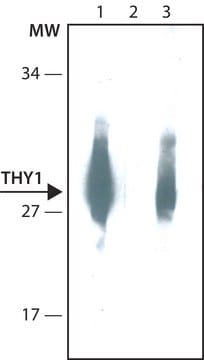MABS2278
Anti-Oxidized phospholipid Antibody, clone EO6
Sinonimo/i:
OX-Phospholipid, Ox-PC
About This Item
Prodotti consigliati
Origine biologica
mouse
Livello qualitativo
Forma dell’anticorpo
purified antibody
Tipo di anticorpo
primary antibodies
Clone
E06, monoclonal
PM
calculated mol wt N/A kDa
observed mol wt ~200 kDa
Purificato mediante
affinity chromatography
Reattività contro le specie
all
Confezionamento
antibody small pack of 100
tecniche
ELISA: suitable
immunohistochemistry: suitable
radioimmunoassay: suitable
western blot: suitable
Isotipo
IgMκ
Sequenza dell’epitopo
Unknown
N° accesso ID proteina
N° accesso UniProt
Temperatura di conservazione
-10 to -25°C
Specificità
Immunogeno
Applicazioni
Evaluated by ELISA with Oxidized Phosphatidylcholine-BSA (OxPC-BSA)
ELISA Analysis: A serial dilution of this antibody detected Oxidized-Phosphatidylcholine-BSA.
Tested Applications
Western Blotting Analysis: A representative lot detected OxPL in Western Blotting applications (Horkko, S., et al. (1999). J Clin Invest. 103(1):117-28; Leibundgut, G., et al. (2013). J Lipid Res. 54(10)2815-30).
ELISA Analysis: A representative lot detected OxPL in ELISA applications (Horkko, S., et al. (1999). J Clin Invest. 103(1):117-28).
Immunohistochemistry Applications: A representative lot detected Oxidized phospholipid in Immunohistochemistry applications (Yu, P., et al. (2018). Arterioscler Thromb Vasc Biol. 38(1):26-39).
Radioimmunoassay: A representative lot detected OxPL in Radioimmunoassay applications (Horkko, S., et al. (1999). J Clin Invest. 103(1):117-28).
Note: Actual optimal working dilutions must be determined by end user as specimens, and experimental conditions may vary with the end user.
Descrizione del bersaglio
Stato fisico
Ricostituzione
Stoccaggio e stabilità
Altre note
Esclusione di responsabilità
Not finding the right product?
Try our Motore di ricerca dei prodotti.
Codice della classe di stoccaggio
12 - Non Combustible Liquids
Classe di pericolosità dell'acqua (WGK)
WGK 2
Punto d’infiammabilità (°F)
Not applicable
Punto d’infiammabilità (°C)
Not applicable
Certificati d'analisi (COA)
Cerca il Certificati d'analisi (COA) digitando il numero di lotto/batch corrispondente. I numeri di lotto o di batch sono stampati sull'etichetta dei prodotti dopo la parola ‘Lotto’ o ‘Batch’.
Possiedi già questo prodotto?
I documenti relativi ai prodotti acquistati recentemente sono disponibili nell’Archivio dei documenti.
Il team dei nostri ricercatori vanta grande esperienza in tutte le aree della ricerca quali Life Science, scienza dei materiali, sintesi chimica, cromatografia, discipline analitiche, ecc..
Contatta l'Assistenza Tecnica.








